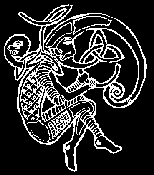All About Ogham
What is Ogham?
Ogham is the mysterious and magical alphabet of the ancient Irish and British Celtic peoples. It is thought to have been invented somewhere around 200 – 300CE by one learned man. There has been no evidence to show that it existed before the Roman era and its structure suggests that it may have been borrowed from the Latin and/or Greek forms. Ogham is almost unique to Ireland where it can be found carved onto more than 300 ancient standing stones. In comparison there are around 40 Ogham stones in Wales, 8 in England, 5 on the Isle of Wight and only 2 in Scotland with orthodox inscriptions.
The origin of the word “Ogham” is uncertain but it has been associated with the name “Ogma”, a member of the Irish mythical, god-like race, the Tuatha de Danaan. Ogma was a Sun god, known as Ogma Grianaineac (Sun Face) or Ogma Cermait (Honey-tongued) whom Irish mythology tells us is the inventor of Ogham. In the ancient ‘Book of Ballymote’, an important reference for scholars of Ogham, we are told that “Ogma, much skilled in dialects and poetry, as proof of his intellect, invented Ogham for signing secret speech known only to the learned, to the exclusion of rustics and herdsmen.”.

The ‘learned’ would of course refer to the Druid classes where Ogham was an essential part of their training. Apprentices spent 3 years learning the Ogham by heart, it has been suggested that it may have been used as a kind of sign language as the Druids themselves did not like to write anything down. Most of what is known about the Ogham is derived from ‘The Scholar’s Primer’, a 7th century work of grammarians or ‘linguistics experts’ of the time and part of the ‘Book of Ballymote’.
In the Scholar’s Primer, which is available to read online here , we learn that the letters of the Ogham alphabet, historically called ‘feda’ but nowadays known as ‘fews’ are mostly named after trees. If we study the ‘Briathaogaim’ or ‘word oghams’ we can see that this was not always the case but it seems that at some point the ‘Celtic Tree Alphabet’ and Ogham were ‘fused’ together – the beginning sounds of the name of each tree becoming associated with each letter.
In time other Oghams developed for birds, animals, herbs, places, Saints etc .. once again based on the beginning sounds of their names so, for example, the first letter sound in the Ogham is ‘B’ or ‘Beith’ which means ‘Birch’ .. but it can also stand for ‘Besan’ meaning ‘Pheasant’, ‘Bo’ meaning ‘Cow’ and ‘Brenainn’ – Saint Brendan. The Scholar’s Primer also includes information about the uses of the trees, what can be made from them and the animals and insects associated with them.
One of the mysteries of the Ogham, concerning the trees, is that some of them – ie the Silver Fir, Elm and Vine were not native to Ireland or Britain during the Iron Age. On botanical grounds alone this could indicate that the Ogham originated with the Celts in the old ‘La Tene’ region, located between France, Germany, Switzerland and Italy, except that no Ogham inscriptions have ever been found there?
There are 20 original letters (fews) in the Ogham alphabet and these are grouped into 4 ‘aicmi’ or groups/families of 5. There are also 5 later additions which make up another family known as the Forfeda – these feature in the cover photo for ‘Divine Ogham’. Ogham script is made up of a series of lines (flesc) carved along a central line (druim). It is interesting to note that ‘flesc’ means ‘twig’, and ‘feda’, the original name for ‘fews’ means wood, this could account for the main association with trees. Also the ‘druim’ represents the trunk while the ‘flesc’ represent the branches/twigs of the tree.

Ogham and Divination
There is very little known about Ogham divination as the ancient Druids were so secretive in their practises, only passing on their knowledge to the ‘initiated’. We do however, find a few vague records, two of which follow below ..
In the old Irish tale, “The Wooing of Etain”, a druid named Dalan cut 4 wands out of yew wood onto which he inscribed 3 Ogham symbols. He then used them to ‘divine’ where the god Midir had taken Etain.
In the poems of Taliesin, Dalan says:
“I am Taliesin,
Chief of the Bards of the West.
I am acquainted with every sprig
In the cave of the Arch-Diviner.”
On the very fragmented 2nd century Celtic ‘Coligny Calendar’ there are references to ‘Prinni Louden’ and ‘Prinni Layet’ which mean ‘the casting of the woods’ and ‘the laying of the woods’ respectively. This might well point to days for Ogham divination?
In the ‘Ogham Tract’, a 7th century source of information, also to be found in the Scholar’s Primer, it is indicated that there is more to the Ogham alphabet than just ‘sounds’. There are other meanings and mythological associations attached to the letters/fews. These associations are what makes divination with Ogham possible, just as with the Viking Runes and the Chinese I-Ching.
The ‘wands’ used in Ogham divination today are known as ‘staves’. Beautiful sets can be purchased from Spirit of Old If making your own, please do not cut twigs from living trees, instead look for the fallen twigs from a favourite tree 😉

